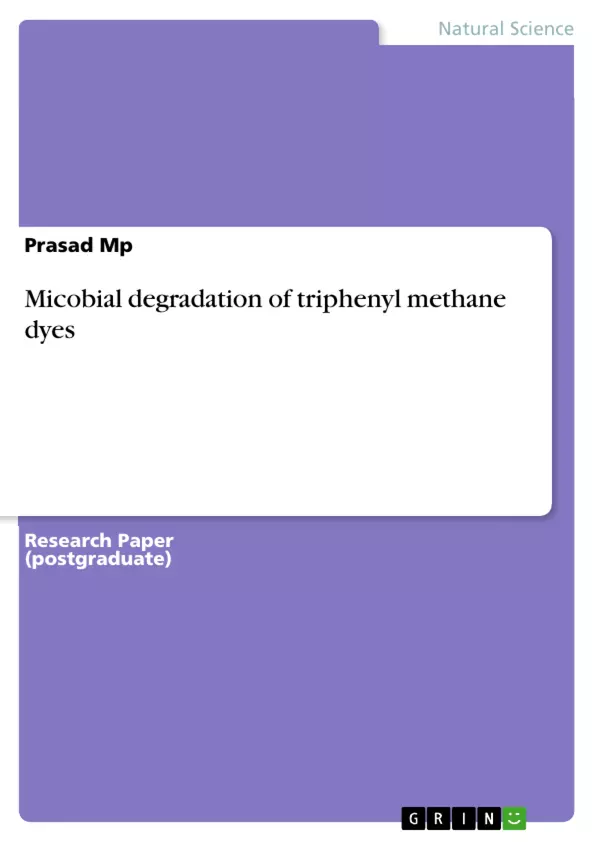Try phenyl methane dyes have been found in soil and river sediments as consequences of improper chemical waste disposal. 10000 dyes and pigments are produced annually world wide amounting to 7*107tones which are hazardous and pose serious environmental problems. It is estimated that 10-15% of the dye is lost in the effluent during the dying process. Try phenyl methane dye decolorizing bacteria have been isolated; there are few reports of specific enzymes that decolorize these dyes. Isolate bacterial strains which had the capability to decolorize textile dye like bromophenol blue, crystal violet and malacate green. We estimate the decolorization percentage for all the three tri phenyl methane dyes and quantify the activity of the TMR enzyme that degrades try phenyl methane dye and characterize the dye degrading organism as pseudomonas species.
Inhaltsverzeichnis (Table of Contents)
- Abstract
- Introduction
- Materials and Methods
- Isolation of the dye degrading organism
- Decolorization assay
- TMR Enzyme assay
- Characterization of the bacterial isolates
- Results and Discussion
- Conclusion
- References
Zielsetzung und Themenschwerpunkte (Objectives and Key Themes)
This research aims to investigate the ability of bacterial strains to decolorize triphenyl methane dyes, which are commonly found in soil and river sediments due to improper chemical waste disposal. The study focuses on identifying and characterizing bacteria capable of degrading these dyes, particularly bromophenol blue, crystal violet, and malachite green. Additionally, the research explores the enzymatic activity responsible for dye degradation and examines the potential of using these bacteria for bioremediation of dye-contaminated environments.
- Microbial degradation of triphenyl methane dyes
- Identification and characterization of dye-degrading bacteria
- Enzymatic activity involved in dye degradation
- Bioremediation of dye-contaminated environments
Zusammenfassung der Kapitel (Chapter Summaries)
The Introduction provides a comprehensive overview of the environmental impact of dyes, particularly triphenyl methane dyes, emphasizing their widespread presence in industrial wastewater and the resulting pollution. The Materials and Methods section outlines the experimental procedures for isolating and characterizing dye-degrading bacteria, including the decolorization assay and the TMR enzyme assay. The Results and Discussion section presents the findings of the research, analyzing the decolorization efficiency of different bacterial strains and identifying the enzyme responsible for dye degradation. The Conclusion summarizes the key findings and discusses the potential applications of the research.
Schlüsselwörter (Keywords)
The primary focus of this research lies on the microbial degradation of triphenyl methane dyes, specifically bromophenol blue, crystal violet, and malachite green. The research utilizes techniques such as isolation and characterization of bacteria, decolorization assays, and enzymatic activity analysis to understand the mechanisms involved in dye degradation. The research emphasizes the potential for using these bacteria in bioremediation strategies for dye-contaminated environments.
- Citar trabajo
- Prasad Mp (Autor), 2012, Micobial degradation of triphenyl methane dyes, Múnich, GRIN Verlag, https://www.grin.com/document/286443



